2025 Author: Priscilla Miln | [email protected]. Last modified: 2025-01-22 17:55:13
The he alth of cats is known to be strong, and they rarely get sick. However, sometimes in this regard, such pets still deliver problems to their owners. For example, a cat is lame on its front paw - what to do in this case? Do I need to take my pet to the vet? Or is it better to wait until everything is resolved by itself?
Main causes of lameness
In 99% of cases, such a nuisance occurs in cats due to injury. Other causes of lameness can be:
- osteochondrosis;
- arthritis or arthrosis;
- elbow dysplasia;
- osteomyelitis;
- infection;
- pretending.
In some cases, a cat's paw can recover without taking any measures. In others, the animal must be shown to a specialist.
Why the cat is lame on the front paw: injury
As already mentioned, it is for this reason that the cat begins to limp on its paw most often. If the owners have noticed that it is difficult for their pet to step on the front paw, they should just remember if something has happened recently.anything that could cause injury. A cat can limp, for example, after an unsuccessful jump. Also, the animal's paw may start to hurt after someone steps on it, pinches it with a door, etc. In addition, quite often a similar problem is observed in those cats that are let out for a walk on the street. A pet can get injured from other animals, after an unsuccessful jump, etc.

Lameness due to injury can be mild or severe. In any case, if a pet is found to have such a problem, it is worth examining it first. If the lameness is caused precisely by an injury, a wound or swelling will most likely be found on the paw. In that case, the owner of the animal should just wait a day. Most likely, the cat's injury, if he can still step on his paw, will pass after this time.
If the cat does not stop limping in a day, it should be taken to the veterinarian. The doctor will examine the animal, make the correct diagnosis and prescribe treatment.
The reasons why the cat began to limp on the front paw may be:
- cuts and punctures;
- fractures and dislocations;
- splinters.
Also, for example, a cat can break a claw in case of an unsuccessful jump. In this case, the animal will subsequently experience quite severe pain for a long time and, accordingly, will begin to limp.
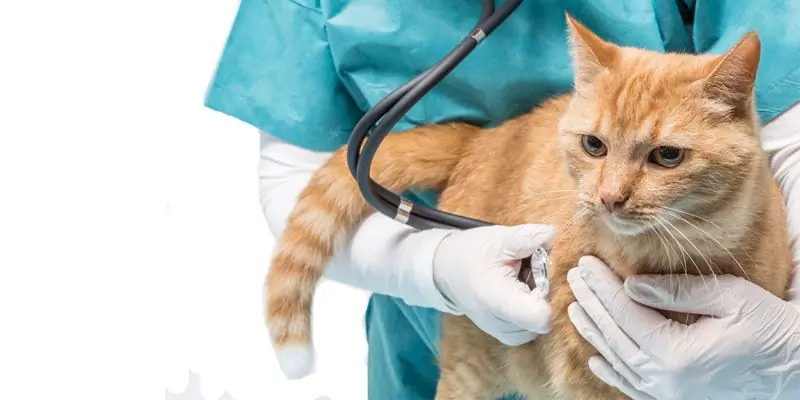
Arthritis and arthrosis
This problem usually occurs in fairly old animals. In this case, lameness, of course, is notappears suddenly. At first, it becomes only a little difficult for the pet to step on the foot. Then the problem gets worse.
If a cat limps on its front paw with arthritis, what should I do in this case? If there is such a problem, the pet will need to be shown to a specialist. Unfortunately, it is almost impossible to cure arthritis or arthrosis in older animals. Your doctor will likely prescribe only supportive care.
Elbow Dysplasia
This disease occurs in both young and old cats. Unfortunately, pedigreed purebred animals are especially susceptible to it. Cattery owners often use this method of breeding expensive cats as inbreeding. In this case, kittens are born with pronounced breed characteristics. However, inbreeding significantly increases the risk of developing hereditary diseases in offspring. One of these ailments is elbow dysplasia.
Signs of this disease in a pet can appear at a very early age. However, lameness in a cat with such a problem becomes most noticeable at 2-3 years of age. Of course, it is impossible to allow the breeding of such animals. Also, the cat must be taken to the veterinarian.

Like arthrosis, it is unlikely to cure dysplasia in a pet. However, the doctor will still choose a treatment regimen that will make the cat's life more comfortable. The main symptoms of this disease in cats, in addition to lameness, are:
- crunching sounds when moving;
- X-shaped curvature of the limbs;
- stiffness when standing up.
Osteomyelitis in cats
If a domestic cat limps on its front paw, this may also indicate that he has developed this dangerous disease. The disease in this case also manifests itself gradually. Osteomyelitis is a disease associated with bone necrosis, accompanied by a purulent-inflammatory process.
Most often this unpleasant disease occurs in cats under the age of 2 years. At the same time, pets of the Persian breed are considered the most susceptible to it. Veterinarians attribute this to hereditary predisposition. Osteomyelitis is usually treated in a complex way - through surgery, as well as medications.
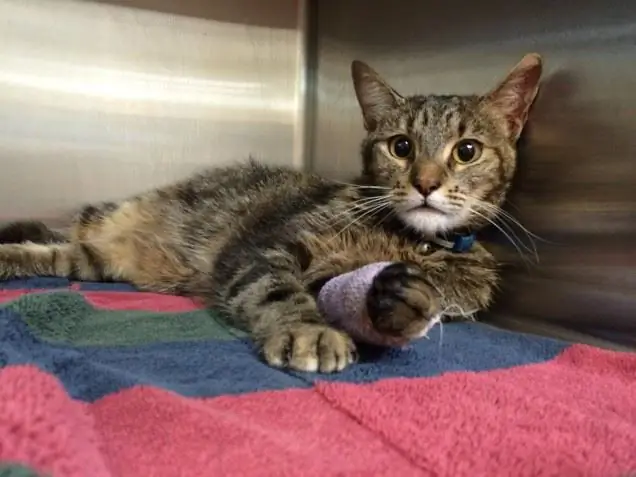
Lameness due to infection
If the cat began to limp on his front paw, he may have contracted calcivirosis. This disease of an infectious nature is very easily transmitted from a sick animal to a he althy one. For prevention, many owners of cats vaccinate them against this disease. Animals that have not been vaccinated can become very easily ill with calcivirosis.
In addition to lameness, signs of this disease can be:
- breathing disorder;
- conjunctivitis;
- nasal discharge;
- damage to paw joints;
- presence of ulcers on the mucous membranes.
This disease causes inflammation of the anterior joint chambers. That is why the cat is lame on the front paw. What should the owners do in this case? With calcivirosisthe animal, of course, should be shown to a specialist. Treatment in this case is prescribed complex - therapeutic and symptomatic.
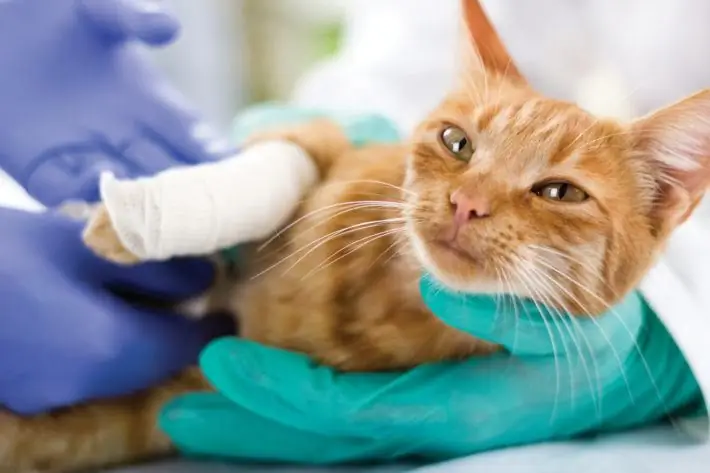
Another infection that can cause lameness in a cat is a fungus. In this case, dermatophytes often affect not only the pads of the animal or its skin, but also the claws or joints. Lameness in cats in this case develops due to inflammation.
Pretending
Sometimes it happens that the animal has no visible damage, but still the cat is limping on its front paw. The reason in this case may simply be the nature of the animal. A pet whose paw is slightly pinched or, for example, stepped on it, may be offended. In this case, the cat, even if he does not feel any discomfort in his paw, starts defiantly limping just to express his indignation to the owners.
If the lameness is purely emotional, the animal's paw will most likely show no damage. At the same time, after a couple of hours the cat will get tired of playing, and he will stop limping.

When should a cat be taken to the veterinarian?
When do you need specialist help? When an animal has at least one of the following symptoms:
- the cat cannot walk at all or moves with great difficulty;
- when touching the paw, the pet meows and sharply pulls it away;
- the cat does not step on its paw, pressing it when moving.
Alsoa specialist is worth a visit if the lameness in a cat is accompanied by loss of appetite, high fever, increased fatigue, lethargy or aggression. These are already very disturbing symptoms.
The cat is limping on the front paw. What to do in this case, how to give the pet first aid?
As already mentioned, a lame animal should be left alone for one day, and then taken to the veterinarian. Also, if a bruise is detected during the examination, cold can be applied to the affected area for 1 minute, wait 20 seconds and apply again for 1 minute. This operation should be repeated for 5 minutes.
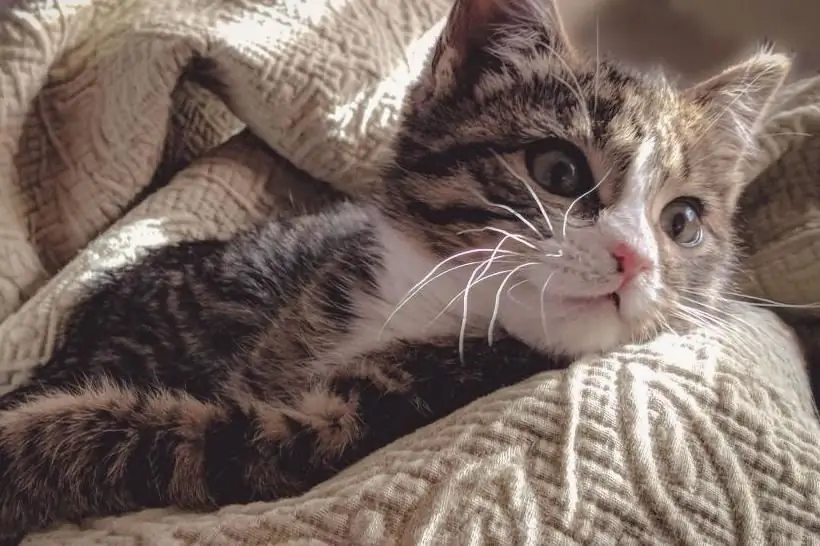
If the owners suspect that the cat has a fracture, he should try to fix the paw. In this case, you need to take the animal to the clinic in an immobilized state. You can also try to provide first aid to a cat if it has a minor wound. In this case, the affected area must be carefully cleaned with a cloth dipped in soapy water to remove dirt. After that, the wound should be treated with a solution of furacilin and the animal should be taken to the veterinarian.
Recommended:
Fistula in a cat: causes, how to treat
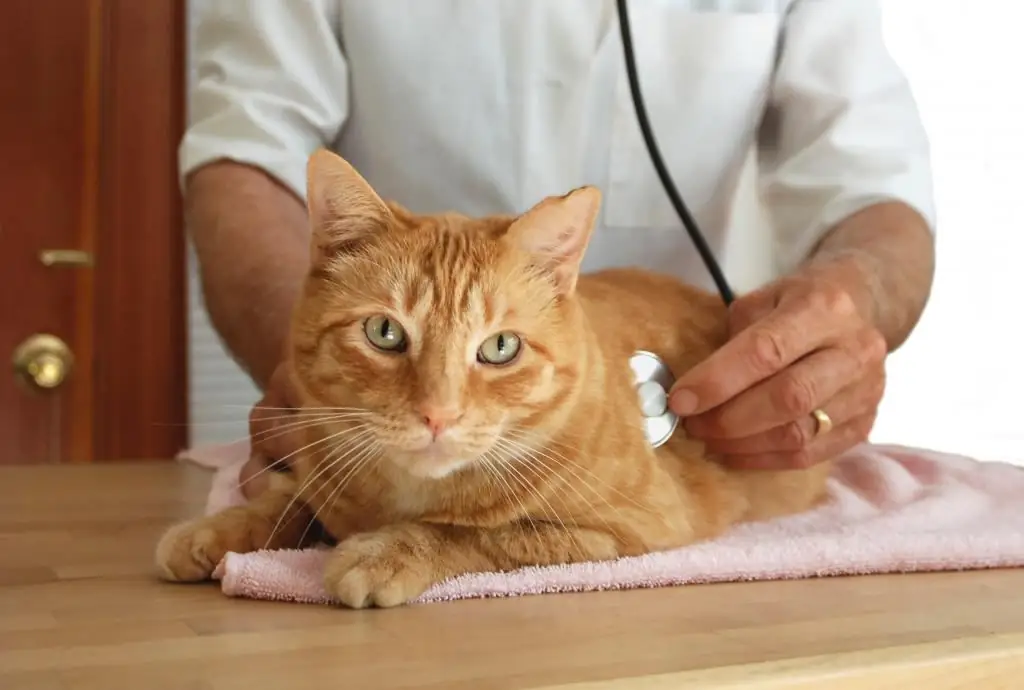
A fistula is a channel connecting cavities or organs with the external environment or with each other. Outwardly, it looks like a purulent wound, but the consequences of its improper treatment are extremely dangerous and can lead to sepsis (blood poisoning), and ultimately to the death of the animal
How to treat conjunctivitis in a cat at home?
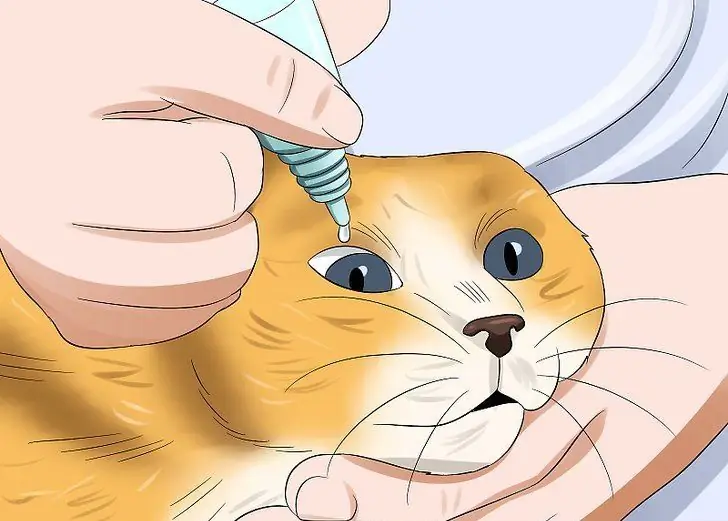
To understand how to treat conjunctivitis in a cat, you need to find out the nature of the disease. It can be infectious, allergic, traumatic. For treatment, ointments, drops, washings, various preparations are used. Only a veterinarian can prescribe a course of therapy, since there are different causes of the disease
Can children be transported in the front seat? At what age can a child ride in the front seat of a car?
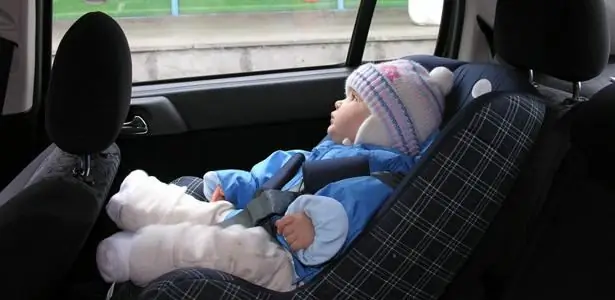
Many parents wonder: "Is it possible to transport children in the front seat?". In fact, there is a lot of controversy about this issue. Someone says that it is extremely dangerous, and someone is a supporter of convenient transportation of the child, because he is always at hand. This article will talk about what is written about this in the legislation, as well as at what age a child can be transplanted into the front seat
The cat has a stuffy nose: what to do and how to treat?
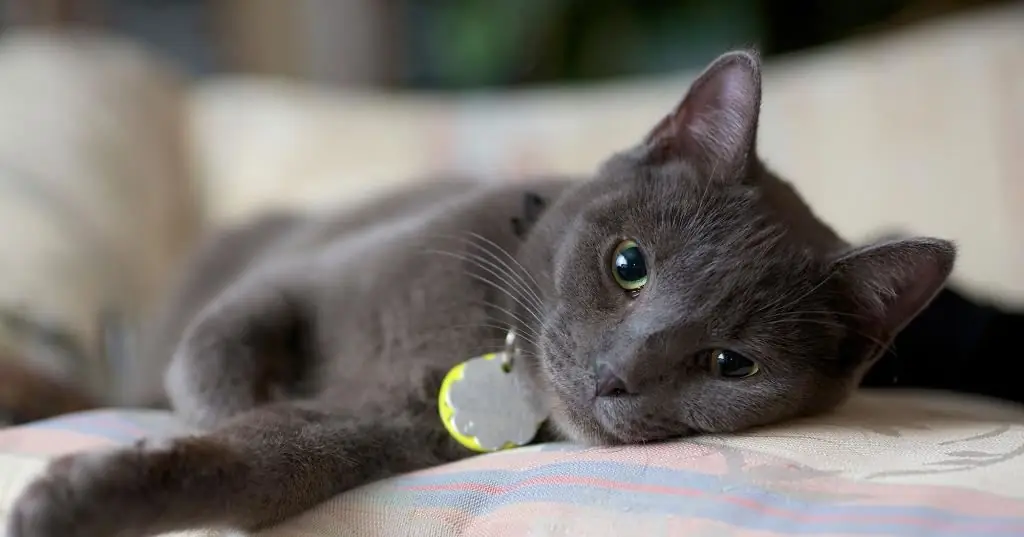
The cat has a stuffy nose. How to be? If the owner is attentive to the animal, he will be able to see the changes that have occurred to him. If the mood of the kitten has become dull, and the appetite is sluggish, then it is likely that the pet is sick. In no case should you ignore your pet's sniffling, as this may be a sign of a cold or a more serious illness
Blessing the mother of the bride in front of the registry office

The blessing of the mother of the bride (as well as the parents of the groom) is a very beautiful ceremony that came to us from antiquity. Then it was given great importance. If the words of the bride's mother's blessing were not spoken, earlier the bride and groom were not allowed to get married in the church. In addition, the girl was disinherited and shamed in society

